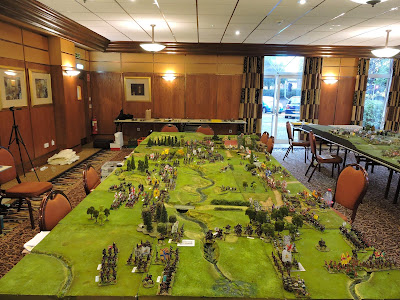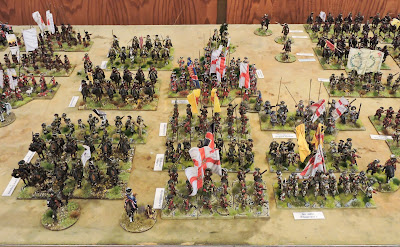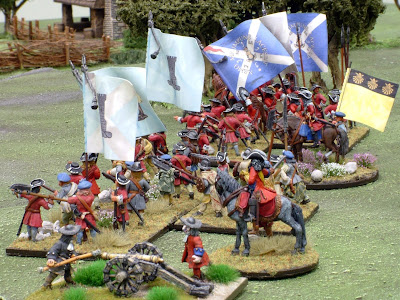 |
| The climactic Battle of Badon Hill |
Continuing the story of our mini campaign of the battle for Britain in 1692 created around an alternative history post July 12, 1691.
Creating the forces for each commander was enjoyable and challenging in equal measure. I had to think about balancing the number, quality, fighting style, weaponry and durability with the character of the commander and the player personalities (each of whom I am pretty familiar with).
 |
| Scots Dragoons operating in the Middle March of the Borders in July 1692 |
The size of force was roughly equivalent to between three and four brigades. The number of units was influenced by their armament and the quality/proportion of their weapons.
Many of the units were named historical formations such as the Scots Dutch Brigade or the Highland clans of Cameron and Macdonald. I created some imaginary units such as The Earl of Dunfermline's Regiment of Foot, The Oxford City Volunteer Cavalry, The Monmouthshire Fuzileers and Colonel Robert Lundie's Fuzileers (this infamous historical character finding himself serving with the Jacobite Army following his escape from Derry).
 |
| Privateers bombarded Berwick town and Lochiel almost escaped captivity as a result |
With the acquisition of plunder, variable sized war chests, looting and recruitment amongst the player group we saw the formation of new regiments on player requests. These included Colonel Blakeney-Edwards Regiment of Horse, Colonel Polrowan's English Guards (a Cornish volunteer unit recruited by the Jacobites to send the political signal that King James had a regiment of 'English' Guards under command), The London Gentlemen Volunteer Cuirassiers, Lord Forbes Highland Regiment (fighting for King William), The Lancashire Volunteers and 2nd Battalion of Sir Maurice Eustace's Regiment.
 |
| The Lancashire Volunteers turned out for King James |
In this first focus on players' forces we are looking in detail at two of the commands the first of which is a fairly conventionally constructed Jacobite force.
Lieutenant General Richard Hamilton's Command
Richard Hamilton was the general who conducted the first military campaign of the war, marching from Dublin through Ulster and reaching Derry in April 1689. I decided to make him a central stabilizing figure in the Jacobite command who lands in western Cornwall accompanied by The Duke of Berwick. His force was composed of mostly experienced Irish troops.
Lord Galmoy's Brigade
Lord Galmoy's Regiment of Horse: An Irish cavalry regiment of 12 models. Classed as Blade Horse. Graded as Veteran and given the suffix of Elite.
Colonel Parker's Regiment of Horse: An Irish cavalry regiment of 12 models. Classed as Blade Horse. Graded as Drilled.
Independent Command
Colonel Tyler's Regiment of Dragoons: A mounted Irish regiment of 12 models. Graded as Drilled and armed with flintlocks.
 |
| General Richard Hamilton's Command |
The King's Brigade under Sir Michael Creagh, Mayor of Dublin
1st Battalion, The King's Regiment of Foot: An Irish regiment of 18 models. Formed as 'Regulation' ie the standard proportion of pike to shot. Equipped with flintlock muskets. Graded as Drilled and given the suffix of Elite.
2nd Battalion, The King's Regiment of Foot: An Irish regiment of 18 models. Formed as 'Regulation' ie the standard proportion of pike to shot. Equipped with flintlock muskets. Graded as Drilled and given the suffix of Elite.
Colonel John Hamilton's Regiment of Foot: An Irish regiment of 18 models. Formed as 'Regulation' ie the standard proportion of pike to shot. Graded as Drilled.
Sir Michael Creagh's Regiment of Foot: An Irish regiment of 18 models. Formed as 'Regulation' ie the standard proportion of pike to shot. Graded as Drilled.
 |
| Some Jacobite units were still poorly equipped and trained |
Richard Nugent's Brigade
The Earl of Clancarty's Regiment of Foot: An Irish regiment of 18 models. Formed as 'Regulation' ie the standard proportion of pike to shot. Graded as Drilled.
Sir John Fitzgerald's Regiment of Foot: An Irish regiment of 18 models. Formed as 'Pike & Shot' ie a higher proportion of pike to shot. Graded as Raw.
Colonel Richard Nugent's Regiment of Foot: An Irish regiment of 18 models. Formed as 'Pike & Shot' ie a higher proportion of pike to shot. Graded as Drilled*.
Colonel Richard Butler's Regiment of Foot: An Irish regiment of 18 models. Formed as 'All musket' with no pikes. Graded as Drilled.
*Nugent's were recalled to Ireland in the first month of the campaign.
The second command is less conventional, that of
Viscount Dundee
Of course Dundee died in 1689 at Killiecrankie but I warped history and had him survive the bullet to recover and re enter King James's service as his Generalissimo in Scotland.
 |
| Scots soldiers from the English army deserted and rallied to Dundee at Moffat |
Brigadier Graham's Brigade
Viscount Dundee's Regiment of Horse: A Scots regular cavalry regiment of 6 models. Classed as Bullet Horse. Graded as Drilled and escort to the King's standard in Scotland.
Lord Gordon's Gentlemen Volunteer Regiment of Horse: A regiment of Scottish gentlemen at arms comprising 6 models. Classed as Bullet Horse. Graded as Raw.
Independent Command
Colonel Cannon's Regiment of Dragoons: A dismounted Irish regiment of 12 models. Graded as Drilled and armed with flintlocks.
Brigadier Cameron of Lochiel's Brigade
Cameron of Lochiel's Bodyguard: A Highland regiment of 12 models. Graded as Drilled and given the suffix of Elite.
Macdonalds of Glengarry: A Highland regiment of 18 models. Graded as Drilled.
Macdonalds of Clanranald: A Highland regiment of 12 models. Graded as Raw.
Macdonalds of Sleat: A Highland regiment of 12 models. Graded as Raw.
Sir Alexander Maclean's Regiment: A Highland regiment of 12 models. Graded as Drilled.
 |
| Viscount Dundee's unconventional command |
The Lord Gordon's Brigade
The Lord Gordon's Regiment of Foot: A Scots regiment of 18 models recruited from the north east. Formed as 'Pike & Shot' ie a higher proportion of pike to shot. Graded as Raw.
The Earl of Dunfermline's Regiment of Foot: A Scots regiment of 18 models recruited from the central lowlands. Formed as 'All pike' ie a containing a negligible number of muskets. Graded as Raw.
The Earl of Seaforth's Regiment of Foot: A Highland Scots regiment of 18 models equipped in the conventional manner for lowland infantry. Formed as 'All musket' ie a containing no pikes and carrying flintlock muskets purchased personally by the Earl. Graded as Raw.
The Earl of Dumbarton's Regiment of Foot: A Scots regiment of 13 models raised from the veteran's of the army who stayed loyal to King James and who rallied to the colours at Moffat. Formed as 'All musket' with no pikes. Graded as Drilled.
 |
| Lord Galmoy had built a fearsome reputation in Ireland between 1688-91 |
A further four Jacobite commands participated in the campaign: General Wauchope's , The Duke of Berwick's, General Sarsfield's and General Sheldon's. The final command was that of the Marquis de St Ruhe which will feature separately.
